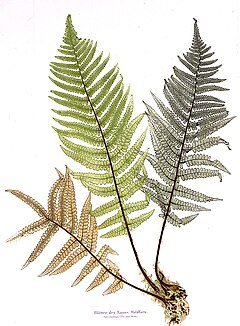Nature printing is a printing process, developed in the 18th century, that uses the plants, animals, rocks and other natural subjects to produce an image. The subject undergoes several stages to give a direct impression onto materials such as lead, gum, and photographic plates, which are then used in the printing process.

While some sources state that Benjamin Franklin invented nature printing from leaf casts, using a copper plate press, in 1737 to thwart counterfeiters of paper money bills,[1] other sources also report Franklin's friend, Philadelphia naturalist Joseph Breintnall, to have made contact nature prints from leaves in about 1730.[2] Together they sent nature prints which were printed directly from inked leaves to English naturalists.[3]

Another person attributed with the invention of the process, Naturselbstdruck, is Alois Auer; the first publication, of instructions for the process, was by this Austrian printer in The Discovery of the Natural Printing Process: an Invention ... Vienna, 1853. This was written in four languages by the author. He shows the use of plants, a fossil fish, and lace impressed by roller onto a lead plate, this is hand coloured and transferred to the final print.

Many others botanical and natural history illustrations had attempted to use techniques that were a 'shorthand', or for a type of accuracy, in the representation of subjects. Another printer, the Englishman Henry Bradbury, immediately used Auer's 'nature printing' process to publish work of his own. These included two major botanical works;
- The Ferns of Great Britain and Ireland, Moore, Thomas.[4] (1857) and the rendition of these species was readily adapted to the process; the two dimensional print would reveal form and detail for the identification of species.
- The Nature-Printed British Sea-Weeds, W. G. Johnstone & A. Croall. 1859–60.[5]
Sherman Denton in his book As Nature Shows Them: Moths and Butterflies ... used the wings of the species he was describing by pressing them into the page itself. For this work he used over 50,000 insects.[6]
Auer method
editAuer's method can only be used with objects with tolerably flat surfaces, such as dried and pressed plants, embroidery and lace, and a few animals. The object is placed between a plate of steel and another of lead, both of which are smooth, and polished. They are then drawn through a pair of rollers under considerable pressure. When the plates are separated, it is found that a perfect impression of the object has been made in the leaden plate. This may be used directly as an engraved plate, but only if a very few impressions are wanted, for it is too soft to resist the action of printing presses for practical purposes. For larger numbers of images, a facsimile to be used as the printing plate is made in copper by the electrotype process.[7]
Further reading
edit- Eric P. Newman, "Newly Discovered Franklin Invention: Nature Printing on Colonial and Continental Currency," The Numismatist (1964)
References
edit- ^ FEDERAL RESERVE BANK OF PHILADELPHIA (2007). "Federal Reserve Bank of Philadelphia Releases New Benjamin Franklin Publication". FEDERAL RESERVE BANK OF PHILADELPHIA. Retrieved 2010-07-26.
In 1737 Franklin invented the art of nature printing from leaf casts, using a copper plate press, for transferring a sage leaf image onto the back of paper money bills, a technique intended to thwart counterfeiters.
- ^ Georgia B. Barnhill. "Benjamin Franklin's Job Printing". ABAA (This article first appeared in Ephemera News or The Ephemera Journal, publications of The Ephemera Society of America, Inc.). Retrieved 2010-07-26.
The [leaf printing] technique was not well known at the time, although the Philadelphia naturalist Joseph Breintnall made contact nature prints from leaves about 1730.
- ^ James N. Green and Peter Stallybrass (2006). "Benjamin Franklin: Writer and Printer". The Library Company of Philadelphia. Archived from the original on 2010-10-01. Retrieved 2010-07-26.
Franklin probably got the idea of printing images of leaves on paper money from making these nature prints, which he and Breintnall sent to English naturalists. They were printed directly from inked leaves, which were placed inside a folded sheet of paper and run through the press.
- ^ The Ferns of Great Britain and Ireland; Edited by John Lindley. Nature-printed by Henry Bradbury. London: Bradbury & Evans, 1857.
- ^ Johnstone, William Grosart & Alexander Croall. The Nature-Printed British Sea-Weeds: A History, accompanied by figures and dissections, of the algæ of the British Isles. Four volumes. London: Bradbury & Evans, 1859–60. Text available on Google books here.
- ^ Denton, Sherman Foote (1900). As nature shows them : moths and butterflies of the United States, east of the Rocky Mountains : with over 400 photographic illustrations in the text and many transfers of species from life. Boston, U.S.A: J.B. Millet. p. vi. Retrieved 22 January 2016.
- ^ Gilman, D. C.; Peck, H. T.; Colby, F. M., eds. (1905). . New International Encyclopedia (1st ed.). New York: Dodd, Mead.
- Iris Snyder (Curator). "Nature printing". Color printing in the nineteenth century. University of Delaware Library. Retrieved 2007-09-02.
External links
edit- Media related to Nature printing at Wikimedia Commons